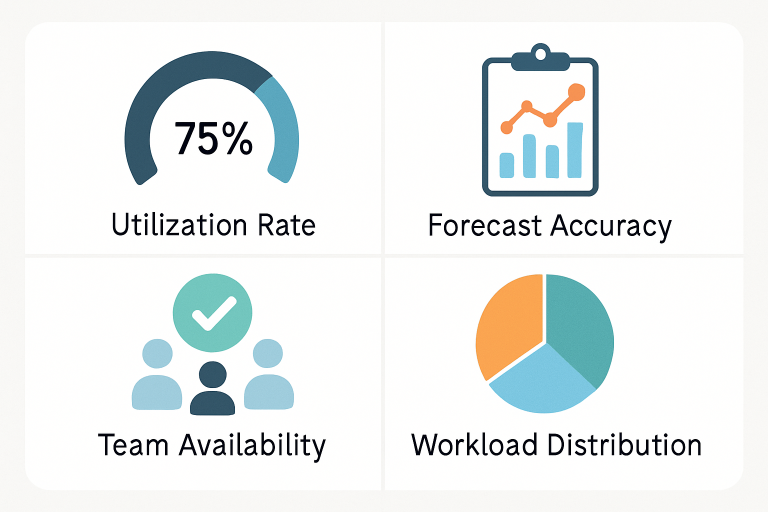Key Takeaways
- Capacity modeling helps organizations align resources, demand, and performance for sustainable growth.
- Tracking the right KPIs—such as utilization rate, forecast accuracy, and workload distribution—supports better decision-making.
- Data-driven capacity strategies reduce inefficiencies, prevent burnout, and improve project predictability.
- Consistent monitoring of metrics fosters adaptability and resilience in fast-changing business environments.
- A proactive approach to capacity modeling enhances operational stability and supports long-term scalability.
Introduction
Organizations striving to achieve operational excellence and stay competitive recognize the critical importance of effective capacity modeling. The right metrics form the foundation for strategic decision-making, allowing companies to anticipate constraints, optimize headcount, and align output with end-user expectations. Organizations should understand the core data behind capacity modelling to unlock these benefits and track the KPIs that reveal real-time insights about their processes.
Robust capacity modeling aligns historical performance and forecasted demand with available resources, ensuring each business unit can deliver against growth goals without overstretching teams. Monitoring targeted metrics informs incremental improvements, providing a buffer against shifting customer requirements and unforeseen issues. Whether managing small project teams or enterprise-scale operations, capacity modeling driven by the right KPIs leads to heightened resilience and better long-term planning.
By developing an evidence-based approach, managers can pinpoint and resolve inefficiencies before they escalate, optimize budgets, and build structures that effortlessly adapt to change. In this article, we’ll break down the most critical metrics that support effective capacity modeling, enabling a consistently high level of performance and operational sustainability.
Utilization Rate
Among the most fundamental metrics, utilization rate is calculated as the percentage of working hours spent on productive tasks out of total available work hours. This benchmark exposes how efficiently staff or equipment are engaged, helping prevent overwork and idle time. For example, organizations often target a utilization rate of 75%- 85% for full-time employees to maintain steady productivity while minimizing burnout. Consistently tracking utilization rates makes identifying when to redistribute workload or invest in automation easier.
Forecast Accuracy
Forecast accuracy captures an organization’s ability to predict future resource demand, comparing estimates to actual results. Correcting forecast precision is essential since inaccurate forecasts lead to overstaffing, lost revenue, or missed deadlines. Leveraging historical data, updating projections frequently, and incorporating technology-driven analytics can significantly enhance this metric. According to Harvard Business Review, data-driven forecasting helps businesses adapt swiftly and allocate resources more effectively, strengthening resilience in uncertain markets.
Capacity Utilization Ratio
The capacity utilization ratio reveals how close you are to maximizing your available output. Calculated as actual output divided by maximum possible output, this figure is crucial for manufacturers, service-based businesses, and any operation where production limits exist. High ratios indicate efficient resource use, whereas low ratios often highlight untapped capacity or operational bottlenecks. Balancing shifts and scheduling regular maintenance can improve this vital figure, allowing for greater output without additional investment.
Planned vs. Actual Hours
Comparing planned hours to actual time spent on tasks reveals whether projects are accurately estimated and exposes sources of inefficiency. When actual hours routinely exceed plans, it may signal flawed estimation, scope creep, or unexpected complications. Conversely, when actual hours fall well below estimates, it could indicate over-allocation or missed opportunities for completing additional work. Adjusting future forecasts based on these findings helps fine-tune capacity strategies.
Team Availability
Assessing team availability means accounting for all factors that impact how much time each employee can dedicate to project work. Absences, holidays, meetings, and training sessions can all erode true availability, leading to unrealistic project commitments if not carefully tracked. By understanding each team member’s capacity, leaders can ensure fair workloads, avoid burnout, and make timely decisions about hiring, outsourcing, or shifting priorities.
Workload Distribution
Well-balanced workload distribution is essential for morale and operational efficiency. Regularly visualizing and reviewing assignments allows managers to spot bottlenecks or identify underutilized individuals, those at risk of overload. Imbalances not only hinder project outcomes but can also impact employee satisfaction and retention. Using collaborative tools to monitor activities and hours per team member helps keep allocations equitable across the board.
Lead Time and On-Time Delivery
Lead time measures how long it takes from order placement to final delivery, while on-time delivery tracks the percentage of projects completed as scheduled. These customer-facing KPIs link capacity planning with satisfaction and reliability. Consistently meeting or exceeding targets for both metrics proves the effectiveness of capacity modeling, while persistent delays often indicate deeper systemic issues requiring strategic adjustment.
Deferred Projects or Deliverables
Deferred projects provide a direct signal of overstretched teams or misaligned capacity. Monitoring the quantity and frequency of delayed deliverables alerts managers to recurring resource shortfalls. Revisiting resourcing models, automating routine tasks, or temporarily scaling workforce capacity may be necessary to regain balance. This metric is especially critical for growing organizations facing rapid changes in workload and priorities.
Final Thoughts
Measuring and managing the right capacity metrics empowers organizations to allocate resources confidently, boost employee engagement, and ensure consistent delivery against business goals. Companies gain the agility to respond proactively to change, support growth, and create a resilient operational foundation by continuously monitoring utilization rates, forecast accuracy, workload distribution, and other KPIs discussed here.

